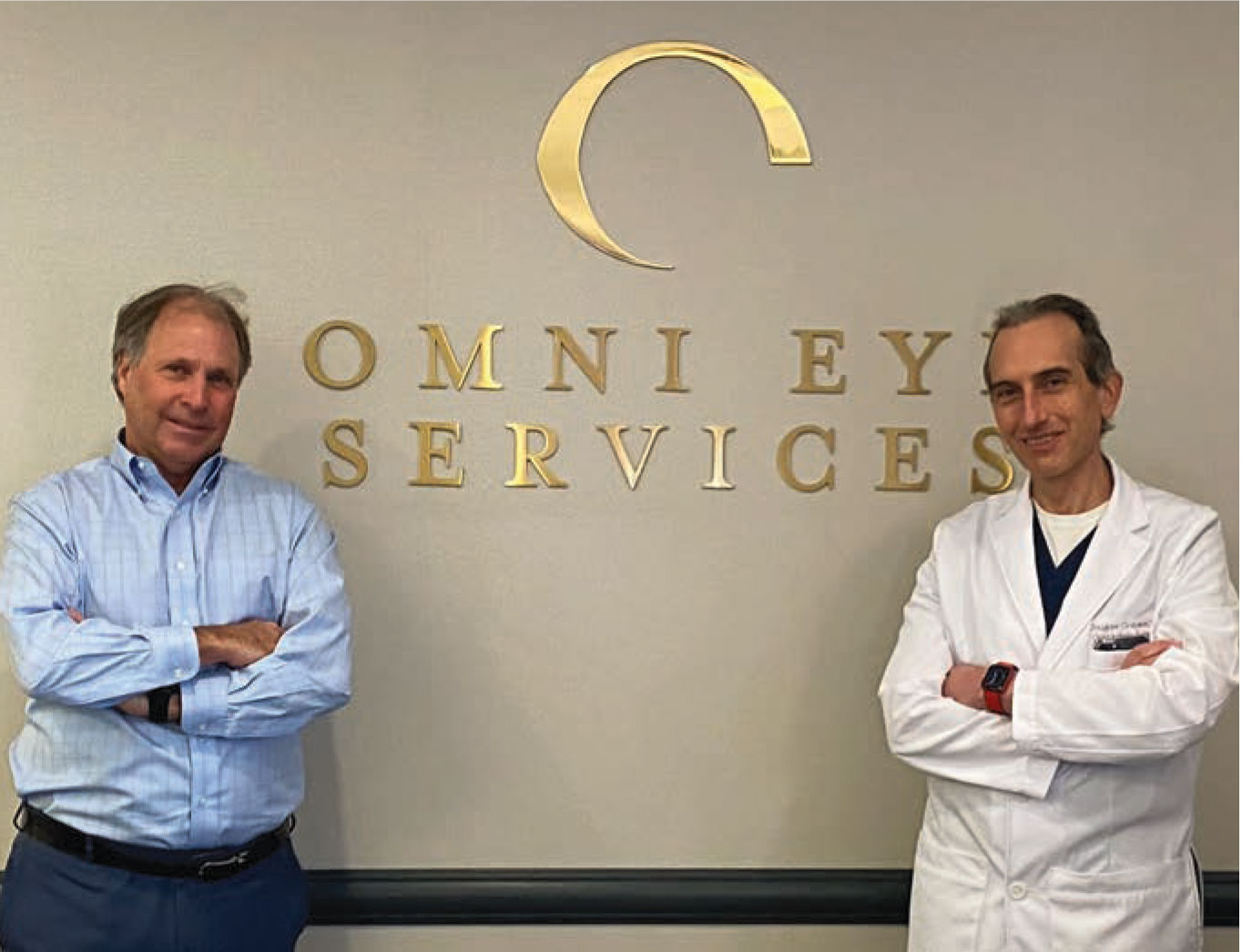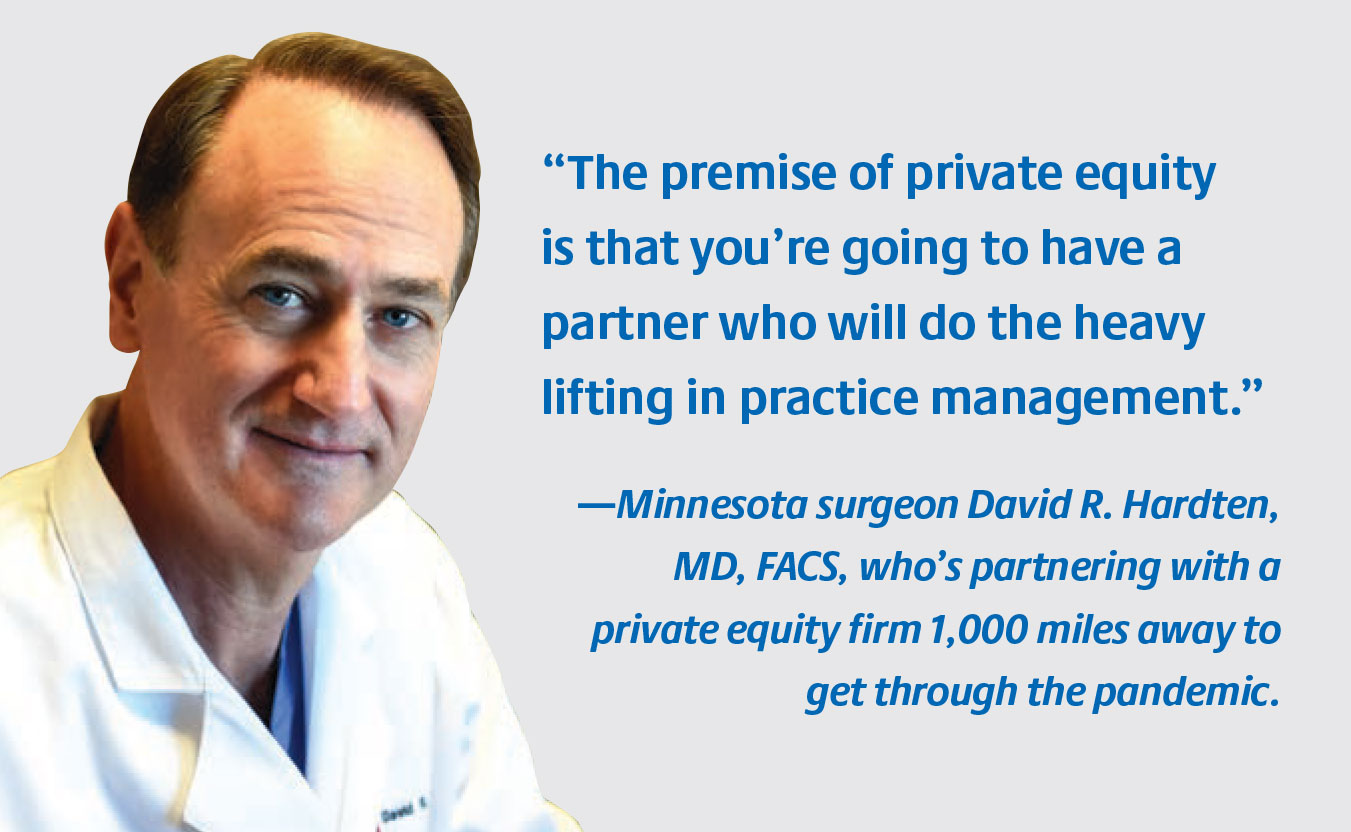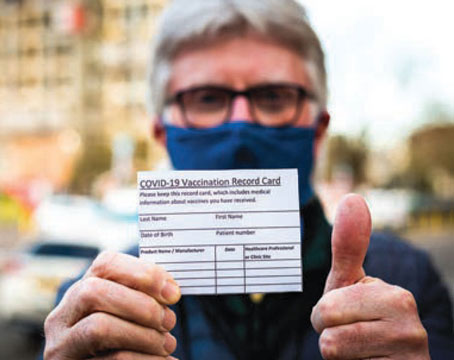
|
March 17, 2020 will be remembered as the date that private equity’s expansion into ophthalmology screeched to a halt. It was one day after former President Donald J. Trump introduced initial emergency guidelines that would eventually shut down large parts of America and two days before a suspension of elective and non-essential surgery, as well as non-essential medical care everywhere.
“On March 16, 2020, we were representing 16 or 17 clients interested in closing private equity deals,” says Bruce Maller, founder and CEO of BSM Consulting, a firm in Incline Village, Nevada, that brokers the sale of ophthalmology practices to investor-financed private equity companies. “On March 17, that number went down to zero. The private equity side of this market disappeared.”
Like all effects of the pandemic, this one wasn’t permanent, however. What has followed since has been a return of private equity sales, although fewer of them, and a changed and still-evolving private equity environment that can still benefit doctors. Deals are more complicated now, experts like Mr. Maller say, and yet doctors in solo or smaller practices are also more eager to at least explore the potential opportunities these transactions might represent, including protection against near-calamitous shutdowns, shrinking reimbursements and a sweeping merger-mania that’s eating away at the turf of traditional, independent private practitioners.
In this report, consultants and ophthalmologists with deep experience in this field advise you on whether private equity is the right fit for you, signs of strong and supportive corporate platforms, financial risks and benefits and how to increase your leverage. They’ll also explain new ways to keep younger, employed doctors from deserting a practice before a sale.
Why Private Equity?

|
| Chief operating officer Christopher J. Quinn, OD, and Douglas K. Grayson, MD, a cataract and glaucoma surgeon, are bullish on the post-COVID future of their private equity organization, Omni Ophthalmic Management Consultants, one of four major private equity platforms in the New York and New Jersey metropolitan area. |
Private equity companies, capitalized by investors, have been increasingly purchasing private practices in ophthalmology for the past four to five years, continuing a trend that also swept through radiology, anesthesiology, dermatology, orthopedics and other specialties during the past 15 years, according to Steven I. Rosenfeld, MD, FACS, President of Delray Eye Associates in Delray Beach, Florida.
Dr. Rosenfeld, whose five-partner practice sold Delray Eye Associates to a private equity firm two years ago, is recognized for offering expert advice on private equity in the era of COVID-19 during panel discussions at the most recent meeting of the American Academy of Ophthalmology. Although virtually all ophthalmology practices lost a fiscal quarter’s worth of revenue because of virus-related shutdowns in 2020, he says private equity companies continue to be attracted to post-pandemic practices that are recovering financially, especially when the doctors—both partners and non-partners—represent a range of career stages and plan to stay at the practice after the sale, reflecting a commitment to continuity. The companies also look for the potential to increase profits by adding doctors, merging with or acquiring additional practices and introducing or increasing noncovered services, such as offering facial rejuvenation, premium intraocular lenses, refractive surgery, use of the femtosecond laser for cataract surgery and even, in some settings, optical dispensaries.
“The way the model works, the private equity firm is one step away from the practice,” Dr. Rosenfeld says. “A private equity firm that buys several practices usually creates a platform, called a medical services organization, or MSO, which hires a talented and experienced CEO who assembles a corporate team with the knowledge and business acumen to run the platform and acquire additional practices.”
He says his practice’s private equity partner manages business matters better than the doctors, freeing up time for the practice to concentrate on patient care, and also leverages pooled national resources to negotiate better prices on everything from employee health-care insurance to ophthalmic equipment. He and his colleagues believe their corporate partner will help them survive reimbursement cuts and thrive competitively as health care consolidates around them, controlling access to tens of millions of patients through accountable care organizations, hospital networks and corporate entities.
To secure Delray Eye Associates’ position as an island of semi-independent practice, Dr. Rosenfeld says private equity provides the “deep pockets” to add a surgery center or other assets to benefit the doctors and their patients. The expanding bandwidth of the practice through acquired practices spawns increased referrals to their tertiary care practice, which offers glaucoma, cornea, retinal, neuo-ophthalmology and oculoplastic services.
The downside of selling to private equity is that you lose autonomy. “It’s a paradigm shift,” admits Dr. Rosenfeld. “Most ophthalmologists who run their own practices are used to having total independence. In this model, the private equity firm makes the final decisions.” At the same time, he notes, a carefully selected private equity company that’s the right fit for you won’t want to overhaul your practice. “They’re buying you because you’re profitable and your practice has its own ‘secret sauce.’ And, you know how to meet the needs of your local community,” he says.
What About Non-Partners?
One challenge you may face if you’re a private practice owner thinking of selling to private equity, or if you’re an employed doctor in a private practice, is that these deals have discouraged employed doctors from participating. Employeed doctors typically stand to lose in two ways:
- never becoming a partner once a practice is owned by a corporation; and
- having to settle for a lower salary once the corporation takes over the practice.
Some former owners who have sold their practices to private equity say increased payments associated with more referrals in their expanding, networked settings have filled a gap by increasing younger, employed doctors’ opportunities to perform procedures and care for more patients. The centralized management and financial security of a private equity company that enables practices to purchase coveted equipment and negotiate better contracts with commercial payers can also satisfy younger doctors. Another factor is that many younger doctors, seeking a healthy work-life balance, may not feel deprived because they’ve never been interested in becoming practice partners, declining to take on the rigors of ownership, with all of its management headaches.
Nonetheless, productive salaried, younger doctors who account for high patient volume are highly desired by private equity, experts say. If they leave to pursue other opportunities, it could kill a deal.
New solutions to this challenge have emerged. Sometimes, Dr. Rosenfeld notes, you can now create incentives for younger doctors who aren’t partners when you join private equity.
“You can give bonuses to younger employees who are on a partnership track,” he says. “You might want to expedite a physicians’ entry into partnership at the time of the private equity sale, or you can offer these younger doctors equity in the new platform to provide an incentive for them to come along. Someday, they’ll be rewarded by growth on their investment when the practice is sold to a second private equity organization.”
| Close-up on a Private-Equity Sale Attorney Mark E. Kropiewnicki, Esq, LLM, says too many doctors he consults with don’t fully grasp how much they’ll earn if they sell their practices to a private equity company. Here’s what to consider about these transactions, which are based on Earnings Before Interest, Depreciation Taxes and Amortization (EBIDTA). “Let’s say you’re a solo doctor grossing $1 million per year and your overhead is 60 percent, resulting in $400,000 in net income that goes into your pocket,” says Mr. Kropiewnicki, an attorney with Health Care Law Associates and a consultant with the Health Care Group, both in Plymouth Meeting, Pennsylvania. “That 60 percent is what I call real overhead, including all of the expenses of running the practice, except the doctor’s salary. So how much EBIDTA is there? Well, in reality, there’s no EBIDTA—if you pay yourself $400,000 a year. So, one of the ways private equity can enter into a deal with you, the selling doctor, is to tell you that you’ll be paid at 30 cents on every dollar you earn, instead of 40 cents, after the transaction. That frees up $100,000 per year. If you negotiate a multiple of seven on your cash payment, you’re looking at a $700,000 payment for your practice.” (Mr. Kropiewnicki’s example excludes ancillary and other revenue you would surrender to the private equity company after you sell the practice.) “So after the sale, you’ll receive 30 percent of the revenue you earn—nothing more. But you do get that $700,000 upfront payment in cash, minus the amount of equity (20 to 40 percent of $700,000) that you agree to invest into that practice that you’ve just sold to help it expand, as a condition of the sale. You’ll be entitled to collect that equity and growth on that equity, when you leave the practice.” If you plan to leave practice in four or five years, Mr. Kropiewnick says the deal probably makes sense. “If you sold the practice to another doctor, you’d probably get $300,000 to $400,000. This is because the value of the practice to a buying private doctor isn’t the same as it is to a private equity firm. The private equity firm wants to buy the practice, grow it and sell it to earn a multiple of 15 or 20 times their initial investment later on. That’s the way private equity thinks: ‘We’ll buy this is at a multiple of seven, set up our platform practice here, expand with some add-on practices, increase volume and private pay services, drive up the EBIDTA, and then take the platform to market in five years, selling it at a multiple of 15. “The doctor who is five years away from retirement says, ‘I’ll take the $700,000, plus growth on my equity investment. That’s better than I would get from selling the practice to another doctor for $300,000 or $400,000. I can also still earn $300,000 dollars a year working for private equity.’ But in essence, you’re also losing out on $100,000 a year that used to be included in your earnings. So, you’d need to do the math to see if the private equity deal is worth it to you. It may depend on how many more years you plan to stay in practice.” |
Douglas K. Grayson, MD, a cataract and glaucoma surgeon at Omni Eye Services, owned by Omni Ophthalmic Management Consultants, one of four major private equity practices in the New Jersey-New York City area, agrees with the need to respect the leverage of employed doctors in advance of today’s equity deals. The need to share “some type of financial interest in the practice” with the employed doctor may be paramount. He recommends that practice owners and employed doctors communicate in advance of potential private equity opportunities—or missed opportunities—to avoid misunderstandings and hard feelings among all parties.
What’s Changed Post-COVID-19
The structure of private equity deals remains the same despite the pandemic’s squeezing down of 2020 practice revenue. However, the payments you can expect to receive if you sell your practice are lower. Below is a summary of pre-COVID-19 and post-COVID-19 terms, according to Drs. Rosenfeld and Grayson and Mr. Maller.
• Pre-COVID-19 practice sales. Ophthalmologists with an ownership stake in practices were paid a multiple of the strategic value of their practices, ranging from five to 10 or higher. (The strategic value is the practice’s Earnings Before Interest, Depreciation, Taxes and Amortization, or EBIDTA.) As part of the sale pre-or-post-pandemic, the selling doctors have been obligated to invest 20 to 40 percent of the cash payment they receive back into the newly formed private equity practice, an investment that can pay them back handsomely if the firm achieves its goal of later selling off the practice at multiples of 15 to 20, typically in five to seven years. As always in private equity arrangements, the selling doctors have remained as employees in the practices they’ve sold, earning a reduced percentage of their billings.
• Post-COVID-19 practice sales. Although the structure of these deals remains the same, the upfront multiples paid on a practice’s EBIDTA are “a bit softer,” according to Mr. Maller. Dr. Grayson concurs, adding that an offer to an ophthalmologist in a successful but small private practice might be the practice’s EBIDTA at a multiple of four or five instead of 10 or higher. “Some acquisition contracts will be worded differently than they were previously,” says Dr. Grayson. “Everybody’s more cautious now. In some cases, for private equity companies, the EBIDTAs of the practices after they were purchased weren’t as high as expected in recent years, because the private equity companies may not have been rigid enough in terms of the performance criteria they’d put in place.”

|
Meanwhile, if you sell to private equity now, your EBIDTA will be based on 2019 revenue, but your upfront payment will be reduced, at least temporarily. For example, Mr. Maller says, private equity might pay 80 percent of the usual initial payment. Dr. Rosenfeld adds: “If your practice achieves agreed-upon goals in one or two years, the withheld funds, called an earnout, will be turned over to you. But if the practice doesn’t fully recover or achieve the desired goals, then a certain percentage of this earnout will be withheld. This approach represents the most significant change in how these deals have been done since COVID.”
In addition, because of the paralyzing effect the pandemic temporarily imposed on ophthalmology practices for at least the second quarter of 2020, Mark E. Kropiewnicki, Esq, LLM, an attorney with Health Care Law Associates and a consultant with the Health Care Group, both in Plymouth Meeting, Pennsylvania, says he’s introduced force majeure clauses to contracts related to private equity sales, spelling out conditional terms that will apply unless unforeseeable circumstances (“acts of God or nature”) prevent a party from meeting the terms of the agreement. “I have only used such clauses in real estate contracts until recently,” says the attorney. “Now I put them in every agreement.”
Risks, Hard Work and Rewards
Dr. Grayson says he knows of private practice doctors who as recently as early 2020 were sitting on significant chunks of potential revenue they could’ve earned on sales of their practices to private equity. They were waiting for their practice values to increase even more, but now the pandemic has left them waiting in line for the return of interested private equity companies. “Now they’re being told, ‘Well, let’s see how well you recover,’” says Dr. Grayson. “Of course, as the owner of a private practice, you want the highest number you can get. If you have to get out of private practice now, you have to get out now. It’s like Vegas, because essentially you’re gambling when you wait and then have to make a move.”
Besides accepting risks, you’ll need to invest a lot time and proceed carefully to enter a private equity deal securely.
“Private equity companies tend to get into transactions that are relationship-based,” says Dr. Rosenfeld. “If you have a consultant or someone helping you who is well-known and connected, he or she may be able to assist you in getting the kind of deal you’re seeking.” He says getting involved in private equity can be a year-long process, from the time that a private equity company evaluates your practice as a potential acquisition until the sale is consummated. “A lot goes into it,” he says. “Even the accounting is different. Private equity looks at revenues differently than we do, on an accrual instead of cash basis.” After interviewing a number of private equity companies, Dr. Rosenfeld says you may ask them to submit letters of intent.
“Once you decide which company you want to work with, you sign one of the letters of intent, and then you work with the suitor over the next several months to find out if you can consummate a deal. This process involves a lot of learning, number-crunching, negotiating and compromising before you can arrive at the final deal.”
Mr. Maller speaks to the risks of not exercising appropriate degrees of caution, especially in today’s post-COVID environment. “The experience of COVID has varied among doctors and it’s shined a bright light on the quality and integrity of existing private equity platforms,” he says. “When you’re managing through a crisis, which is what we’re still in, it ordinarily reveals key indicators of stability and lack of stability.” Those indicators, he continues, include:
- the quality, integrity and strength of the leadership of the organization;
- the financial strength of the organization, including cash reserves, good credit and ability to borrow money; and
- the quality of the practice culture and brand.
“In other words,” Mr. Maller continues, “you want to see if the company has been able to weather the storm. If I were to objectively survey all of these companies, the outcome of that assessment, I suspect, would be variable. And variability can affect the satisfaction of the doctors who have joined these groups.”
Mr. Maller says some doctors are relieved that they’ve joined private equity at such a challenging time. “And then we’ll hear other doctors saying, ‘Oh my God, they laid off this person and they took this and that away,’” he says. “The worry and concern are palpable among some of these doctors.”
Meanwhile, if you’re a practice owner who’s getting ready to sell, Mr. Kropiewnicki urges you to understand all aspects of your new reality.
“For example, you may have invested in horizontal expansion, offering a lot of ancillary services that have driven up the value of your practice and attracted a private equity buyer,” he says. “You need to realize that you’ll lose all revenue from those ancillary services,” he says. “The one thing I think a lot of doctors exploring private equity don’t realize is that they’re only going to earn 30 cents on each dollar of their personal billing, or whatever salary they’ve negotiated. The other sources of revenue go away.” (See “Close-up on a Private-Equity Sale.")
Keeping Your Options Open
So why, you may ask, would now be a good time to join a private equity company, if the opportunity presented itself?
“Having survived the pandemic, some practitioners are asking themselves, ‘Do I really want to be alone, either by myself or with 10 or 20 other doctors? Or should the results of the pandemic make me think that my interests would be better served by being part of some larger group or platform?’” muses Mr. Maller. “That’s a fundamental shift in one’s mindset that I’ve witnessed. I would call that a trend that’s developed in this so-called post-COVID landscape: A lot of doctors start re-evaluating their situations.”
David R. Hardten, MD, FACS, an anterior segment surgeon at Minnesota Eye Consultants, which has five locations in the greater Minneapolis-Saint Paul area, says he and his colleagues have benefited from their partnership with private equity from the time they sold their practice to Dallas-based Unifeye Vision Partners four and a half years ago right on through the challenges of the pandemic. Besides Minnesota Eye Consultants, UVP owns Northwestern Eye, also in the Twin Cities, as well two large practices in California, Pacific Eye Institute and Inland Eye Institute.
“The premise of private equity is that you’re going to have a partner who will do the heavy lifting in practice management,” Dr. Hardten says. “Although you’re still going to have input, and suggestions, and you’re going help direct the culture and the flavor of the practice, it will be managed by your private equity company. I suspect that, for someone who isn’t part of a private equity group, the number of hours they’ve spent on practice management during this past year has been higher than the number of hours they’ve spent on practice management during several previous years combined.
“This effort required the doctor in private practice to confront, alone, all of the challenges, twists and turns that we had to overcome during the pandemic,” he continues. “I’m sure that a lot of these doctors are now thinking that it was way too much work. They may envision the advantages in the go-forward environment of a practice with more depth as well as access to increased resources, with the ability to pool those resources across multiple markets. For these doctors, private equity is certainly worth looking at.”
Dr. Grayson is also confident that private equity can ultimately provide a secure landing for many of today’s practices. “The banks are now more inclined to lend money as we get past some of the worst aspects of COVID,” says Dr. Grayson. “Ophthalmology is still a good business. There are many, many people to care for, especially with the patient population aging, so it’s not like it’s going anywhere. There’s still plenty of activity and interest.”
He says COVID-19 seems to have decreased revenues only in the short term. “Patients are happy to come in, and volume is up in most places,” he says. “By the end of the summer, I think most ophthalmology practices are probably going to be the way they were before COVID.”
None of the sources for this article had any relationships with relevant commercial interests to disclose.





